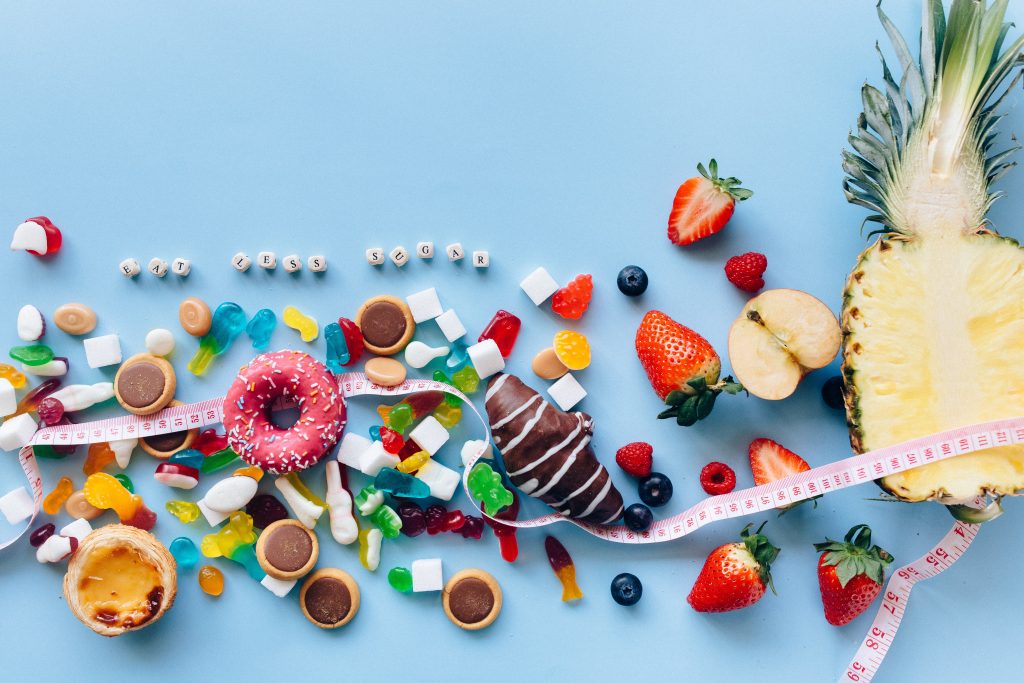Let’s be objective and look at the facts and the data.
The GI is useful, even if you have no diabetes
The Glycemic Index is a useful nutritional concept, permitting new insights into the relationship between the physiological effects of carbohydrate-rich foods and health.
Several prospective observational studies have shown that the chronic consumption of a diet with a high glycemic load (GI dietary carbohydrate content) is independently associated with an increased risk of developing type 2 diabetes, cardiovascular disease, and certain cancers.
You should eat low-glycemic fruits, no matter how diabetic you are
Most of us suffer from too much glucose in our system – and even don’t know it.
80% of non-diabetics are likely to experience glucose spikes, with everyday foods such as breakfast cereal or orange juice.
Or with some fruits.
The symptoms? Many of them sound so familiar.
Cravings, overeating, constant fatigue, apathy, moodiness, infertility, acne, wrinkles… And over time, the development of conditions like type 2 diabetes, cancer, and dementia.
Flattening our glucose curves is a powerful way to feel better
With flatter glucose curves, we can enjoy fewer cravings, better energy, more restful sleep, slower aging, improved fertility and sex hormones, better skin, fewer wrinkles, healthier heart, less cognitive decline, fewer menopause symptoms, easier management of gestational diabetes and type 1 diabetes, and less risk of type 2 diabetes.
Glucose spikes, why they are dangerous
- Because of the blood sugar spikes, our mitochondria become overwhelmed and start producing chemicals called free radicals. Free radicals harm our cells, mutate our DNA, and lead to oxidative stress and inflammation.
- When we spike, our body ages. Each glucose spike leads to glycation, which is the process of aging of our body. Glycation leads to many age-related issues, from cataracts to Alzheimer’s. When we slow down glycation, we live a longer, healthier life.
- Lowering insulin is key to weight loss. When you have glucose in your blood, insulin is released and excess glucose is stored as fat. Weight loss is always preceded by insulin levels lowering.
Fructose gets stored only as fat
Fructose is a kind of sugar called mono-saccharide. Fructose is also known as “fruit sugar” since it is found mostly naturally in many fruits.

Recent studies have shown that excessive consumption of fructose, a type of sugar found in fruits and sweeteners, may be associated with weight gain, fat accumulation, and cognitive dysfunction. The over-consumption of fructose can lead to an imbalance in energy metabolism, with the body converting fructose into fat and storing it in the liver and other tissues. This can result in fatty liver disease and other health problems. Additionally, the excessive consumption of fructose has been associated with cognitive decline and other negative effects on brain function.
When consumed in small amounts, as part of a healthy diet that includes whole fruits and vegetables, fructose is not typically a problem. However, when consumed in large amounts, as found in added sugars, such as high fructose corn syrup, and sugary drinks, it can contribute to weight gain and other health problems. When consumed in excessive amounts, it can lead to liver dysfunction and insulin resistance leading to obesity and metabolic diseases such as type 2 diabetes.
It’s important to keep in mind that consuming high amounts of added sugar, including fructose, can be harmful to your health. Eating a diet that is high in fiber, whole grains, and non-starchy vegetables, and low in added sugars and saturated fats is recommended for overall health.
Avoid high-glycemic fruits, if you are trying to lose weight
And what I can tell you, is: Fruit Sugar is still SUGAR. It may raise your blood glucose levels very quickly.
When we focus on flattening our glucose curves, we reduce cravings, and hunger, and increase time spent in fat-burning mode.
Weight loss can often be a side effect of these changes.
Studies show that when we flatten our glucose curves, we lose more weight, more easily, even if we eat more calories, than if we don’t take care of our glucose levels.
Avoid high-glycemic fruits, if you are trying to lose weight.
What are Low-Glycemic Fruits?
Low-glycemic fruits have a GI (Glycemic Index) of about 1 to 55.
Remember, eat only the whole fruit never juiced or dried.
Fruits without skin have a higher GI.
Fruit Juice has a high GI
Some dry fruits are coated with sugar and syrup before drying to make them sweeter. These are referred to as candied fruit.
These fruits should be avoided due to their harmful effects.
Examples of low glycemic fruits*
*with natural size and without genetic modification, they don’t taste too sweet

Avocado GI = 15
Tomato GI = 15
Cherry GI = 22
Guava GI = 24
Blackberry GI = 25
Grapefruit GI = 25
Raspberry GI = 26
Pear GI = 39
Plum GI = 39
Apple GI = 40
Strawberry GI = 40
Peach GI = 42 Nectarine GI = 43
Apricot GI =46 Grape GI = 46
Orange GI = 51 Banana GI = 51 Mango GI = 51
Okay, looks good
But
Size, texture, viscosity, and ripeness of fruit affect its Glycemic Index.
For example, an unripe banana may have a GI of 30, while a ripe banana has a GI of over 51.
ATTENTION, please!!!
Most fruits in the supermarket are too sweet and have a higher GI.

Just a few decades ago, the fruits were tart and smaller. Modern fruits have become HUGE and sweet, thanks to the human modernization of the agricultural industry. Most so-called “low glycemic fruits” are high in fructose, and because of this, you may want to limit your consumption of modern fruits. I’m talking about all those giant apples, grapes, nectarines, apricots… Be careful.
How we can support our blood sugar levels?
There are several ways to support healthy blood sugar levels, including:
- Eating a diet that is high in fiber, whole grains, and non-starchy vegetables, and low in added sugars and saturated fats
- Getting regular physical activity, such as 30 minutes of moderate-intensity exercise most days of the week
- Maintaining a healthy weight
- Managing stress through activities such as yoga, meditation, or deep breathing exercises
- Avoiding smoking and excessive alcohol consumption
- Monitoring and managing chronic conditions, such as high blood pressure and high cholesterol
- Taking medications as prescribed by a healthcare provider, if needed It is important to consult with a healthcare professional for personalized advice.
A range of nutrients, vitamins, and botanical extracts may help you to support healthy, normal-range blood sugar levels.
The ingredients in the Blood Sugar Support formula have been found to support HbA1c levels within the normal range.
What is HbA1c?
HbA1c (also known as hemoglobin A1c or glycated hemoglobin) is a blood marker that measures the average blood sugar levels over the past 2-3 months. The test is used to monitor the effectiveness of diabetes treatment and to detect diabetes in people who have not been diagnosed.
Hemoglobin is a protein in red blood cells that carries oxygen throughout the body. When glucose (sugar) levels in the blood are high, some of them can bind to hemoglobin, forming a complex called glycated hemoglobin. The higher the amount of glycated hemoglobin, the higher the average blood sugar levels have been over the past 2-3 months.
HbA1c is typically measured as a percentage. For people without diabetes, a normal HbA1c level is below 5.7%. For people with diabetes, the goal is usually to keep HbA1c levels below 7%. However, the target level may be different for each individual and should be discussed with a healthcare professional.
Trying to burn a little bit of fat? What‘s going on? Any results?
Weight loss is always preceded by insulin levels lowering. Lowering insulin is key to weight loss.
FAQs: Low Glycemic Fruits – GI Chart Can Lie
Question: Is the Glycemic Index (GI) useful even if I don’t have diabetes?
Yes, the Glycemic Index is a useful nutritional concept for everyone, providing insights into the relationship between carbohydrate-rich foods and health. Studies have shown that a high glycemic load diet is independently associated with an increased risk of developing type 2 diabetes, cardiovascular disease, and certain cancers.
Question: Should I eat low-glycemic fruits even if I am not diabetic?
Absolutely! Many of us have excess glucose in our system without realizing it. Non-diabetics can also experience glucose spikes from everyday foods like breakfast cereal or orange juice. By consuming low-glycemic fruits, you can reduce cravings, fatigue, and the risk of developing conditions like type 2 diabetes, cancer, and dementia.
Question: How does flattening our glucose curves benefit us?
Flattening our glucose curves by consuming low-glycemic foods can lead to several positive outcomes. These include reduced cravings, increased energy, better sleep, slower aging, improved fertility, healthier skin, heart, and cognitive function, and a lower risk of developing diabetes. By avoiding glucose spikes, we minimize the production of harmful free radicals and slow down the aging process.
Question: Can fructose only be stored as fat?
Fructose, commonly known as “fruit sugar,” is a type of sugar found in fruits and sweeteners. While consuming fructose in small amounts as part of a healthy diet is generally not a problem, excessive consumption can lead to weight gain, fat accumulation, and cognitive dysfunction. The body converts excess fructose into fat, which can result in fatty liver disease and other health issues. It’s important to consume fructose in moderation and be cautious of added sugars found in processed foods and sugary drinks.
Question: Should I avoid high-glycemic fruits if I’m trying to lose weight?
Yes, if you’re aiming for weight loss, it’s advisable to avoid high-glycemic fruits. Fruits, even though they contain natural sugars, can still raise blood glucose levels quickly. By focusing on flattening your glucose curves, you can reduce cravings, hunger, and increase the time spent in fat-burning mode. Studies have shown that managing glucose levels effectively can lead to more successful weight loss, even if you consume more calories.
Question: What are examples of low-glycemic fruits?
Here are some examples of low-glycemic fruits (with natural size and without genetic modification):
Avocado: GI = 15
Tomato: GI = 15
Cherry: GI = 22
Guava: GI = 24
Blackberry: GI = 25
Grapefruit: GI = 25
Raspberry: GI = 26
Pear: GI = 39
Plum: GI = 39
Apple: GI = 40
Strawberry: GI = 40
Peach: GI = 42
Nectarine: GI = 43
Apricot: GI = 46
Grape: GI = 46
Orange: GI = 51
Banana: GI = 51
Mango: GI = 51
Question: Can the size, texture, and ripeness of fruit affect its Glycemic Index?
Yes, the size, texture, viscosity, and ripeness of fruit can impact its Glycemic Index. For example, an unripe banana may have a lower GI than a ripe banana. It’s essential to pay attention to these factors when considering the GI of a particular fruit.
Question: How can we support our blood sugar levels?
Several ways can help support healthy blood sugar levels, including:
Eating a diet high in fiber, whole grains, and non-starchy vegetables while limiting added sugars and saturated fats.
Engaging in regular physical activity, such as 30 minutes of moderate-intensity exercise most days of the week.
Maintaining a healthy weight.
Managing stress through activities like yoga, meditation, or deep breathing exercises.
Avoiding smoking and excessive alcohol consumption.
Monitoring and managing chronic conditions like high blood pressure and high cholesterol.
Taking medications as prescribed by a healthcare provider, if necessary. It’s crucial to consult with a healthcare professional for personalized advice.
Question: What is HbA1c?
HbA1c, also known as hemoglobin A1c or glycated hemoglobin, is a blood marker that measures the average blood sugar levels over the past 2-3 months. This test is commonly used to monitor the effectiveness of diabetes treatment and detect diabetes in undiagnosed individuals. Hemoglobin, a protein in red blood cells, can bind to glucose when blood sugar levels are high, forming glycated hemoglobin. The higher the amount of glycated hemoglobin, the higher the average blood sugar levels have been over the past few months.
HbA1c, also known as hemoglobin A1c or glycated hemoglobin, is a blood marker that measures the average blood sugar levels over the past 2-3 months. This test is commonly used to monitor the effectiveness of diabetes treatment and detect diabetes in undiagnosed individuals. Hemoglobin, a protein in red blood cells, can bind to glucose when blood sugar levels are high, forming glycated hemoglobin. The higher the amount of glycated hemoglobin, the higher the average blood sugar levels have been over the past few months.
Question:Can weight loss be achieved by lowering insulin levels?
Yes, weight loss is often preceded by lower insulin levels. Lowering insulin is a key factor in weight loss. When glucose is present in the blood, insulin is released, and excess glucose is stored as fat. By managing insulin levels effectively through dietary choices and maintaining stable blood sugar levels, weight loss becomes more achievable.
Read more about one more Lie about Food
Healthy Eating Made Simple: A Calorie Deficit Meal Plan for Women
Weight Loss Plateaus: How Long Will You Be Stuck, Especially as a Woman?
Calorie Deficit Without Sacrificing Flavor: 6 Scrumptious Meals to Try Today
- Antonio Ceriello et al., “Oscillating glucose is more deleterious to endothelial function and oxidative stress than mean glucose in normal and type 2 diabetic patients,” Diabetes 57, no.5 (2008): 1349-1354, https://diabetes.diabetesjournals.org/content/57/5/1349.short
- Louis Monnier et al., “Activation of oxidative stress by acute glucose fluctuations compared with sustained chronic hyperglycemia in patients with type 2 diabetes.” Jama 295, no.14 (2006): 1681-1687, https://jamanetwork.com/journals/jama/article-abstract/202670
- Giada Acciaroli et al., “Diabetes and prediabetes classification using glycemic variability indices from continuous glucose monitoring data.” Journal of diabetes science and technology 12, no.1 (2018): 105-113, https://www.ncbi.nlm.nih.gov/pmc/articles/PMC5761967/
- Zheng Zhou et al., “Glycemic variability: adverse clinical outcomes and how to improve it?,” Cardiovascular diabetology 19, no.1 (2020): 1-14, https://link.springer.com/article/10.1186/s12933-020-01085-6
- Samir Softic et al., “Role of dietary fructose and hepatic de novo lipogenesis in fatty liver disease,” Digestive diseases and sciences 61, no. 5 (2016): 1282-1293, https://www.ncbi.nlm.nih.gov/pmc/articles/PMC4838515/.
- Bettina Geidl-Flueck et al., “Fructose-and sucrose-but not glucose-sweetened beverages promote hepatic de novo lipogenesis: A randomized controlled trial,” Journal of hepatology 75, no. 1 (2021): 46-54, https://www.journal-of-hepatology.eu/article/S0168-8278(21)00161-6/fulltext#%20.
- João Silva et al., “Determining contributions of exogenous glucose and fructose to de novo fatty acid and glycerol synthesis in liver and adipose tissue.” Metabolic engineering 56 (2019): 69-76, https://www.sciencedirect.com/science/article/pii/S109671761930196X#fig5.
- Stryer L (1995). Biochemistry (Fourth ed.). New York: W.H. Freeman and Company. pp. 773–74.





Simply desire to say your article is as astonishing. The clearness for your publish is just nice and i can suppose youre an expert in this subject. Well with your permission allow me to grab your feed to stay updated with impending post. Thanks 1,000,000 and please carry on the enjoyable work.
Just wanna remark that you have a very decent internet site, I enjoy the layout it really stands out.